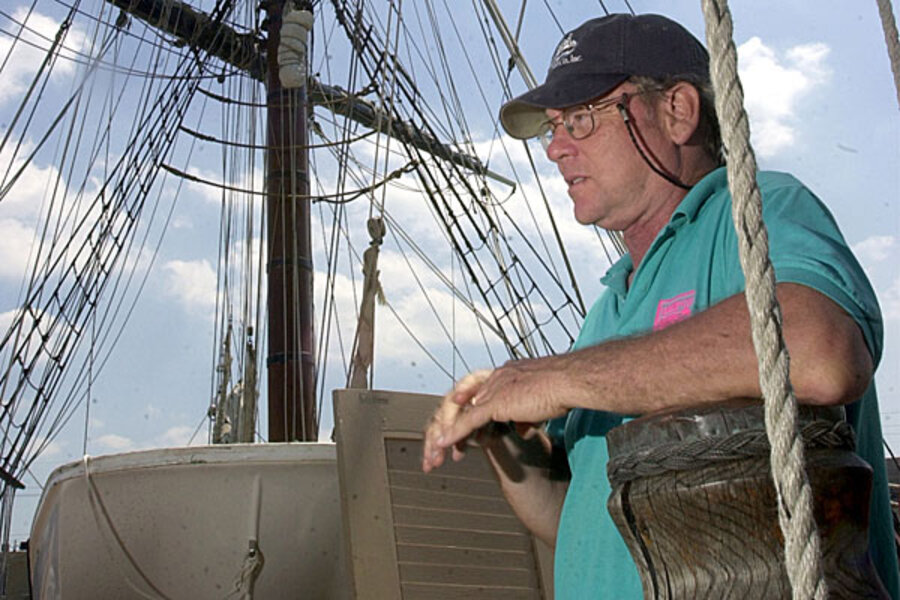HMS Bounty: Search for missing captain continues
| Elizabeth City, N.C. and St. Petersburg, Fla.
The search for the captain of a tall ship that sank in the Atlantic during Sandy is in its third day.
Coast Guard Petty Officer 1st Class Brandyn Hill said Wednesday morning that a cutter searched for Robin Walbridge overnight and two C-130 planes would join the search during the day Wednesday.
Capt. Walbridge was believed to be in a survival suit, and while the seas were still about 15-feet Tuesday, water temperatures were a tolerable 77 degrees Fahrenheit (25 Celsius).
"There's a lot of factors that go into survivability. Right now we're going to continue to search. Right now we're hopeful," Coast Guard Capt. Joe Kelly said Tuesday.
Walbridge had been in a lot of dicey situations as the captain of the HMS Bounty, an 18th-century replica tall ship that was the set of countless movie dramas.
But none of his journeys was as treacherous, perhaps, as navigating through a hurricane churning up the East Coast, becoming part of an epic storm — and a daring rescue — that seemed ripped from the Hollywood films that made the ship famous. The ship was originally built for the 1962 film "Mutiny on the Bounty" and was featured in several other films.
Walbridge's wife describes him as a passionate, experienced captain, one with a cool head and a kind heart. Photos of him on the ship's wooden deck just days before the ill-fated trip show a white-haired man with a steady gaze in a blue windbreaker, a man who was at ease with the sea.
"He's been in many storms," his wife, Claudia McCann, said Tuesday from the couple's St. Petersburg home. "He's been doing this a good portion of his life. He's been in lots of hairy situations and he's very familiar with the boat."
McCann said she talked to him on the phone on his birthday — Oct. 25 — and last heard from him in an email Saturday. He said he and his 15-member crew were prepared to sail around the storm.
But by Monday, the ship began to take on water, its engines failed and the crew abandoned the boat off the North Carolina coast. They were rescued by the Coast Guard, though one member had died. The captain was swept into the sea.
Walbridge's wife waited in their in St. Petersburg home to hear any word, surrounded by friends.
The couple met 17 years ago in Fall River, Massachusetts, during an after-hours reception aboard the ship. It was about the time Walbridge took the ship's helm.
"He was a gentle soul and he was like no one I had ever met before," she said.
About seven years ago, the couple moved to St. Petersburg, which was also where the Bounty has called home off and on since the late 1960s.
Life as a sailor's wife wasn't always easy; they would go months without seeing each other. Sometimes, she took voyages with him, staying in his cramped and rustic sleeping quarters.
"He was a fantastic captain and he was the best in the industry," she said. "He had a reputation that followed him."
Walbridge was a teacher, not only for the visitors to the Bounty, but for his crew, too. They were 11 men and five women, ranging in age from 20 to 66, and many of them weren't experienced on the sea. In a 2010 interview, the captain told a radio station that was how he liked it.
"We take people and we actually put them to work, just like a regular crew member. They will do everything the normal crew does, whether it is steering the boat, setting sails, hauling lines," he told radio station KFAI in Duluth, Minnesota.
Claudene Christian, 42, the crew member who died, was a rookie sailor, but she had a marketing background — and a name and a lineage familiar to anyone who knew the story of the original HMS Bounty, whose crew famously took over the ship from its commander, Lt. William Bligh, in April 1789. The uprising was led by Fletcher Christian, and the story was told in the 1962 Marlon Brando film "Mutiny on the Bounty." It was also featured in one of the "Pirates of the Caribbean" movies.
Claudene Christian said in August she was Fletcher Christian's great-great-great-great-great granddaughter.
"I was at the helm the first week and said, 'Captain, are you sure you're comfortable having a Christian at the helm? I wasn't sure if he got my joke," Christian told The Chronicle Herald of Halifax, Nova Scotia, when the Bounty visited for a tall ships festival.
The crew was tight-knit. One of the more experienced sailors, 66-year-old Doug Faunt, wrote on his blog in May that they seemed to be learning fast and getting along well.
"We had a new crew, most with no experience on BOUNTY, and we're a bit short-handed," Faunt wrote. "The crew has shaken down well."
The Coast Guard did not make the 14 survivors available to reporters, and the group collectively decided not to talk out of respect and sympathy for Christian and Walbridge, said Kimberly Hewitt of Baltimore, whose sister Jessica Hewitt was on board.
___
Dalesio reported from Elizabeth City, North Carolina. Associated Press writers Bruce Smith in Charleston, South Carolina; Jeannie Nuss in Little Rock, Arkansas.; Greg Schreier in Atlanta, and Jeffrey Collins in Columbia, South Carolina, contributed to this report.
Copyright 2012 The Associated Press.





